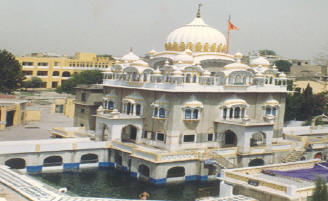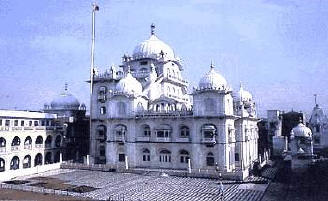Holy Destinations of India
Patna Sahib
 |
 |
Takht Sri
Harmandar Ji, Patna Sahib enjoys the privilege of being the birthplace of
the Tenth Guru Sri Guru Gobind Singh Ji. This sacred place has the honour of
being visited by the first Guru Sri Guru Nanak Dev ji and the ninth Guru Sri
Guru Tegh Bahadur ji. It is from this place that the commandment of valiance
and fearlessness was issued to the Sikh fraternity. The ninth Guru waxed
eloquent about this to justify ways of God to men. "This is why I was born
and set Patna Sahib as my place of work". This very line indicates that Sri
Guru Gobind Singh Ji was born at this sacred place. After bidding an adieu
to his promising childhood at Sri Patna Sahib, Guru Sahib stepped into the
holy land of Sri Anandpur Sahib.
Patna Sahib is regarded as the centre for propagating Sikhism in the east.
At one time, it was called Patliputra.
As history would have it, Takht Sri Patna Sahib is the second accepted and
acknowledged Takht of the Sikhs.
It was 'Sher-e-Punjab' Maharaja Ranjit Singh who, first of all, undertook
the task of raising a monumental Sikh Temple at this place. As a result of
an earthquake, the celestial edifice came to be a heap of dust. With the
co-operation of the Sikh masses, the golden fabric, as it stands today, has
come into its own.
Worthy of visit and homage are historical Gurdwara Gobind Bagh, Gurdwara Bal
Lila, Maini Sangat, Khuh Mata Gujri Ji, Gurdwara Handi Sahib, Gurdwara Gau
Ghat etc.
Patna, ancient Patliputra,
now capital of Bihar State is reverently called Patna Sahib by the Sikhs
because of its consecration by Guru Nanak Dev, Guru Tegh Bahadur and Guru
Gobind Singh. The latter was born here during Guru Tegh Bahadurís tour of
eastern Bihar, Bengal and Assam from 1666 to 1670. Patna Sahib is situated
on the right bank of the River Ganges
PLACES TO VISIT
Gurdwara Pahila Bari
(lit, the first and larger), commonly known as Gurdwšra Gae Ghat, is
dedicated to Guru Nanak Dev, who during his visit to Patna stayed here with
Bhai Jaita, a pious man, confectioner by trade, who became the Guruís
follower and later converted his house into a dharmsala. The congregation
that gathered here came to be called Ban Sangat or Gae Ghat Sangat. Later,
Salas R‚i, a wealthy jeweller, became a convert and took the Guru to his own
place where, too, a small community of Sikh believers was formed into what
was known as Chhoti Sangat. A new building comprising a spacious square hall
with the sanctum in the middle was constructed during the 1980s. Two relics
are preserved here a rebeck claimed to be once Bhai Mardanaís and a stone
called Mata Gujariís grindstone.
Takht Sri Harimandir Sahib, the principal shrine at Patna Sahib and
one of the five Takhts or the highest seats of religious authority for the
Sikhs, marks the site of the Chhoti Sangat. Guru Tegh Bahadur had first
alighted at Ban Sangat at Gae Ghat from where he was brought in procession
to this place which had once been the commodious mansion of Salas Rai, the
jeweller, and where Raja Fateh Chand Maim now built a new house to
accommodate the holy family. Guru Tegh Bahadur himself, leaving his family
here in the care of his brother-in-law Kirpal Chand and the local sangat,
proceeded on further to the east. Guru Gobind Singh was born here on the
seventh day of the light half of the month of Poh in 1723 Bikrami
corresponding to 22nd December 1666.
He spent his early childhood here until his departure for the Punjab in
1670. The house continued to be maintained as a holy place of worship. Its
building was replaced by Maharaja Ranjit Singh during 1837-39 with a square
flat-roofed hail surrounded by a covered passage for circumambulation.
Rulers of Patiala, Jind and Faridkot jointly added several rooms and a
gateway to the compound in 1887. An earthquake in 1934 seriously damaged the
older building of the Takht Sahib. The present five-storey building was
constructed during 1954-57 through kar-seva under the supervision of Sant
Nischal Singh and Sant Kartar Singh. The sanctum sanctorum representing the
room where Guru Gobind Singh was born has a circumambulatory passage around
it. Adjacent is the spacious high-ceilinged congregation hail. The arch of
the door of the inner sanctum opening on the congregation hail is covered
with glided copper plates embossed with floral design matching the marble
sculpture on the interior walls. Of the three canopied seats facing the
hail, the central one has Guru Granth Sahib seated on it with a large-size
portrait of Guru Gobind Singh behind it in place of an officiant. Guru
Granth Sahib is placed on the seat on its right and the Dasam Granth on the
one on the left, both attended by granthis holding whisks over them. The
compound of the Takht Sahib also has several blocks of rooms for staff and
visitors as well as for Guru ka Langar.
Gurdwara Bal Lila Maini Sangat, in a narrow lane dose to Takht the
house where Raja Fateh Chand Maini lived. His childless rani had developed
special fondness for the young Gobind Das, who, too often, came to sit in
the Raniís lap giving her immense delight and spiritual solace. She fed the
Sahibzada and his playmates, at his demand, with salted and boiled gram.
Even now boiled and salted gram is served as Prasad in this Gurdwara, which,
unlike the other shrines is served by nirmala Sikhs. A wood carving on the
old front door is corresponding to 28th August 1668, but the hall housing
the sanctum and other blocks of rooms in the inner compound have been
reconstructed during recent decades.
Gurdwara Sri Guru Gobind Singh Ghat is where the child Gobind Das
used to play with his playmates on the bank of the Ganges. Ghat means a
place on the bank, usually paved, for bathing , drawing water or for landing
or harbouring boats. This ghat, about one furlong from Takht Harminder Sahib
is marked by a gateway over which this gurdwara is situated in a single
room. The river however receded since away to the north.
Gurdwara Guru ka Bagh is about three kilometres east of Takht
Harimandir Sahib where Guru Tegh Bahadur first alighted in a garden
belonging To Nawabs Rahim Baksh and Karim Baksh, nobles of Patna, and where
sangat of Patna came to receive him back from his four year long odyssey.
Its present building was constructed during the 1970s and 1980s. An old well
still in use and dried stump of the imli tree under which Sangat met Guru
Tegh Bahadur, still Exists. The following relics of the Tenth Guru are kept
at the Takht Sri Harmindar Sahib
Cot used by Child Gobind Rai
Four arrows
Small sword
Small Khanda
Small Katar
Kanga made of sandalwood
Kharanwaan Ė Sandals made of ivory both of 9th and 10th Gurus.
Parchment inscribed with alphabets of Panjabi by the young Gobind Rai
The main Gurudwara commemorates the martyrdom
of the two tender Sahibzadas (sons), Zorawar Singh (9 years) and Fateh Singh
(7 years) of the tenth Sikh Guru, Sri Guru Gobind Singh Ji, who refused to
give up their religion under threat from their captor, the Suba of Sirhind.
They were suffocated to death in the dome of Mata Gujri-the grandmother of
these martyrs who could not survive the shock of their martyrdom.
HOW TO REACH
Patna has its own airport and railway station and can be easily reached from any major city in India. Hire a cab or a bus in Patna to visit Patna Sahib.